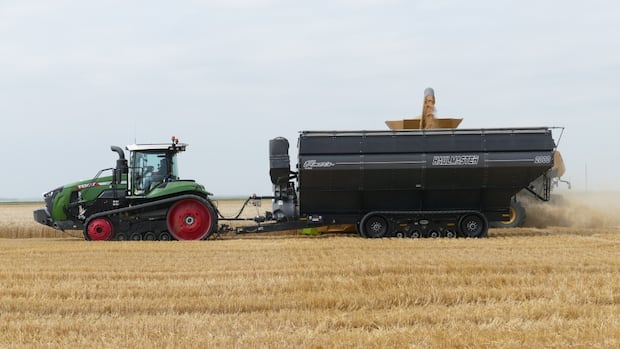US Tariffs: Crushing Canadian Farmers
Editor's Note: The ongoing impact of US tariffs on Canadian farmers is worsening, with new data released today highlighting the devastating effects on the agricultural sector.
Introduction: The imposition of US tariffs on Canadian goods has sent shockwaves through the agricultural sector, leaving Canadian farmers struggling to stay afloat. This article delves into the specifics of how these tariffs are impacting various agricultural products, the economic consequences for farmers, and the potential long-term ramifications for the Canadian economy. We'll explore the challenges faced, the government's response, and what the future holds for Canadian agriculture.
Why This Topic Matters: The agricultural sector is a cornerstone of the Canadian economy, providing livelihoods for countless families and contributing significantly to exports. The US, being Canada's largest trading partner, is a crucial market for Canadian agricultural products. Disruptions to this trade relationship have far-reaching consequences, impacting not only farmers but also related industries like processing, transportation, and retail. Understanding the severity of the situation is crucial for policymakers, businesses, and consumers alike.
| Key Takeaways | |---|---| | Devastating Impact: US tariffs have significantly reduced the profitability of Canadian agricultural exports. | | Economic Ripple Effect: The impact extends beyond farmers to related industries and the overall Canadian economy. | | Government Response: The Canadian government has implemented support programs, but their effectiveness is debated. | | Future Uncertainty: The long-term effects of these tariffs remain uncertain, with potential for lasting damage. |
1. US Tariffs Hitting Canadian Farmers Hard
Introduction: The impact of US tariffs on Canadian farmers is undeniable. Initially focused on specific products like lumber and dairy, the tariffs have broadened, impacting a wider range of agricultural goods. This has led to decreased demand, lower prices, and significant financial losses for many Canadian farmers.
Key Aspects: The tariffs have disproportionately affected certain agricultural sectors. Dairy farmers, for example, have seen a substantial drop in exports to the US, while producers of other goods, such as canola and pork, have also experienced considerable challenges. The retaliatory tariffs imposed by Canada have also impacted US farmers, but the asymmetry of the trade relationship means Canadian farmers are bearing a heavier burden.
Detailed Analysis: Data from Statistics Canada reveals a sharp decline in exports of key agricultural products since the tariffs were implemented. This decrease in export revenue has forced many farmers to reduce production, lay off workers, and face significant financial hardship. The long-term sustainability of many farms is now seriously in question.
2. Interactive Elements on US Tariffs and Canadian Farmers
Introduction: While the impact of the tariffs is readily apparent in raw economic data, the human cost is equally significant. Farmers are facing increased stress, debt, and uncertainty about the future.
Facets: Interactive maps showing the regional variations in the impact of tariffs, combined with farmer testimonials and case studies, can paint a more complete picture of this crisis. Exploring the support mechanisms available to farmers, and their effectiveness, is also critical. We need to consider the psychological toll on farmers and their families struggling with financial instability.
Summary: Understanding the human dimension of this economic crisis is vital to fully grasp the scope of the problem. Interactive elements can bring the data to life, revealing the personal stories and emotional consequences beyond the statistics.
3. Advanced Insights on the Long-Term Effects
Introduction: The short-term pain is undeniable, but the long-term implications for Canadian agriculture are equally concerning. These tariffs could reshape the Canadian agricultural landscape, impacting production, trade relationships, and investment in the sector.
Further Analysis: Experts predict potential long-term shifts in production patterns, with farmers potentially diversifying crops or seeking alternative markets. The long-term effects on inter-provincial trade and the overall health of the Canadian economy also need examination. This requires an in-depth look at the potential for structural changes within the industry.
Closing: The ongoing effects of the US tariffs present a significant challenge to Canadian agriculture. Addressing this issue requires a comprehensive strategy that considers both immediate relief and long-term adjustments to ensure the sustainability of this vital sector.
People Also Ask (NLP-Friendly Answers):
Q1: What is the impact of US tariffs on Canadian farmers? A: US tariffs have significantly reduced the demand for Canadian agricultural products, leading to lower prices, reduced exports, and considerable financial hardship for farmers.
Q2: Why are these tariffs important? A: The agricultural sector is a significant contributor to the Canadian economy. These tariffs threaten the livelihoods of farmers, impact related industries, and could have long-term consequences for Canada's economic stability.
Q3: How can these tariffs benefit the US? A: While intended to protect certain US industries, the tariffs have also had unintended negative consequences on the US economy and agricultural sector due to retaliatory measures from Canada.
Q4: What are the main challenges for Canadian farmers? A: Canadian farmers face challenges including reduced export revenue, increased debt, uncertainty about future markets, and the potential for long-term economic instability.
Q5: How can the Canadian government help? A: The Canadian government can provide financial support programs, explore alternative trade agreements, and invest in research and innovation to help farmers adapt to these challenges.
Practical Tips for Canadian Farmers:
Introduction: While the situation is challenging, there are steps farmers can take to mitigate the impact of US tariffs.
Tips:
- Diversify crops and markets.
- Explore government support programs.
- Improve efficiency and reduce costs.
- Invest in technology and innovation.
- Engage with industry associations and advocacy groups.
- Seek professional financial advice.
- Build strong relationships with alternative buyers.
- Advocate for policy changes.
Summary: The US tariffs are having a devastating impact on Canadian farmers. While the situation is serious, proactive measures and government support are crucial to navigate this challenging period.
Call to Action: Ready to learn more about support programs available to Canadian farmers? Visit the Canadian government's agriculture website for details and resources.

